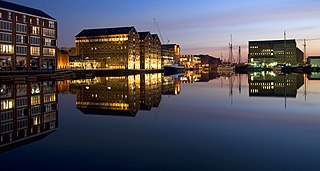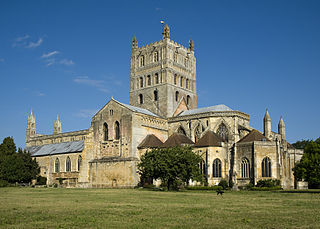
Oswald was King of Northumbria from 634 until his death, and is venerated as a saint, of whom there was a particular cult in the Middle Ages.

Gloucester is a cathedral city and the county town of Gloucestershire in the South West of England. Gloucester lies on the River Severn, between the Cotswolds to the east and the Forest of Dean to the west; it is sited 19 miles (31 km) from Monmouth, 33 miles (53 km) from Bristol, and 17 miles (27 km) east of the border with Wales. Gloucester has a population of around 132,000, including suburban areas. It is a port, linked via the Gloucester and Sharpness Canal to the Severn Estuary.

The Abbey Church of St Mary the Virgin, Tewkesbury, commonly known as Tewkesbury Abbey, is located in the town of Tewkesbury in the ceremonial county of Gloucestershire, England. A former Benedictine monastery, it is now a parish church. Considered one of the finest examples of Norman architecture in Britain, it has "probably the largest and finest Romanesque" crossing tower in England.

Worcester Cathedral, formally the Cathedral Church of Christ and Blessed Mary the Virgin, is a Church of England cathedral in Worcester, England. The cathedral is the seat of the bishop of Worcester and is the mother church of the diocese of Worcester; it is administered by its dean and chapter. The cathedral is a grade I listed building and part of a scheduled monument.

Gloucester Cathedral, formally the Cathedral Church of St Peter and the Holy and Indivisible Trinity and formerly St Peter's Abbey, in Gloucester, England, stands in the north of the city near the River Severn. It originated with the establishment of a minster, Gloucester Abbey, dedicated to Saint Peter and founded by Osric, King of the Hwicce, in around 679.

The King's School is a co-educational private day school in Gloucester, in the county of Gloucestershire, in South West England. It traces its heritage to a monastic school founded in the 11th century in the cloisters of Gloucester Cathedral. It became one of seven 'King's Schools' established, or re-endowed by King Henry VIII in 1541 after the Dissolution of the Monasteries.

The Dean of St Patrick's Cathedral is the senior cleric of the Protestant St Patrick's Cathedral, Dublin, elected by the chapter of the cathedral. The office was created in 1219 or 1220, by one of several charters granted to the cathedral by Archbishop Henry de Loundres between 1218 and 1220.

Oswald of Worcester was Archbishop of York from 972 to his death in 992. He was of Danish ancestry, but brought up by his uncle, Oda of Canterbury, who sent him to France to the abbey of Fleury to become a monk. After a number of years at Fleury, Oswald returned to England at the request of his uncle, who died before Oswald returned. With his uncle's death, Oswald needed a patron and turned to another kinsman, Oskytel, who had recently become Archbishop of York. His activity for Oskytel attracted the notice of Archbishop Dunstan who had Oswald consecrated as Bishop of Worcester in 961. In 972, Oswald was promoted to the see of York, although he continued to hold Worcester also.
David John Briggs is an English organist and composer.

Holy Trinity Church is a Church of England parish church in Westbury-on-Trym, Bristol, England.

The Dean of Christ Church Cathedral, Dublin is dean and head of the chapter of the Cathedral of the Holy Trinity, commonly called Christ Church Cathedral, which is the cathedral church of the United Diocese of Dublin and Glendalough in the Church of Ireland. The dean is appointed by the Church of Ireland Archbishop of Dublin. Aspects of the cathedral administration are overseen by the Cathedral Board, which the Dean chairs with both a regular and a casting vote.
Seiriol John Arthur Evans was an Anglican dean and author in the third quarter of the 20th century.

St Oswald's Priory was founded by Æthelflæd, daughter of Alfred the Great, and her husband Æthelred, ealdorman of Mercia, in the late 880s or the 890s. It appears to have been an exact copy of the Old Minster, Winchester It is a Grade I listed building.
Walter Froucester, was abbot of St. Peter's, Gloucester.
Carolyn Mary Heighway FSA is an archaeological consultant to Gloucester Cathedral and the owner, with her husband Richard Maurice Bryant, of Past Historic, a company which specialises in the design and production of archaeological books and journals as well as exhibitions. She was a founder trustee of Cotswold Archaeology in 1989, and is a fellow of the Society of Antiquaries of London. She is a former president of the Bristol and Gloucestershire Archaeological Society.

John Jones was an English politician who sat in the House of Commons from 1604 to 1611.

Christopher Whall works in Gloucester Cathedral is a narrative list of works that Christopher Whall executed for Gloucester Cathedral.
"Christopher Whall's windows in Gloucester Lady Chapel are arguably the finest post-medieval stained glass in any of our cathedrals, and, with the possible exception of the unexecuted Christchurch Priory designs, his finest large scale work", William Morris Gallery catalogue
John Waugh was Dean of Worcester from 1751 until his death.

Perpendicular Gothic architecture was the third and final style of English Gothic architecture developed in the Kingdom of England during the Late Middle Ages, typified by large windows, four-centred arches, straight vertical and horizontal lines in the tracery, and regular arch-topped rectangular panelling. Perpendicular was the prevailing style of Late Gothic architecture in England from the 14th century to the 17th century. Perpendicular was unique to the country: no equivalent arose in Continental Europe or elsewhere in the British-Irish Isles. Of all the Gothic architectural styles, Perpendicular was the first to experience a second wave of popularity from the 18th century on in Gothic Revival architecture.












